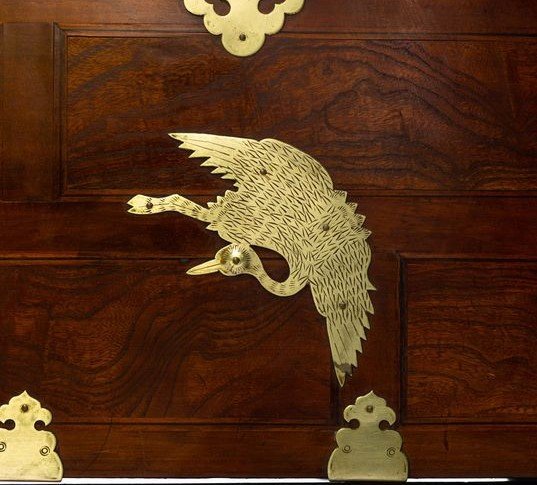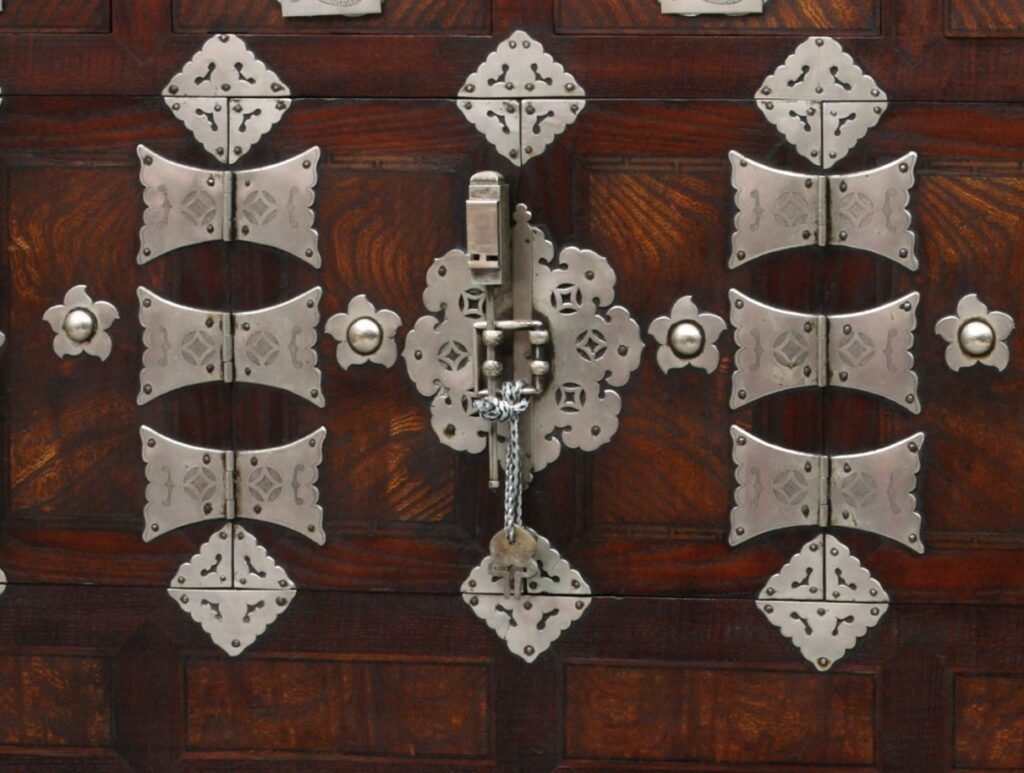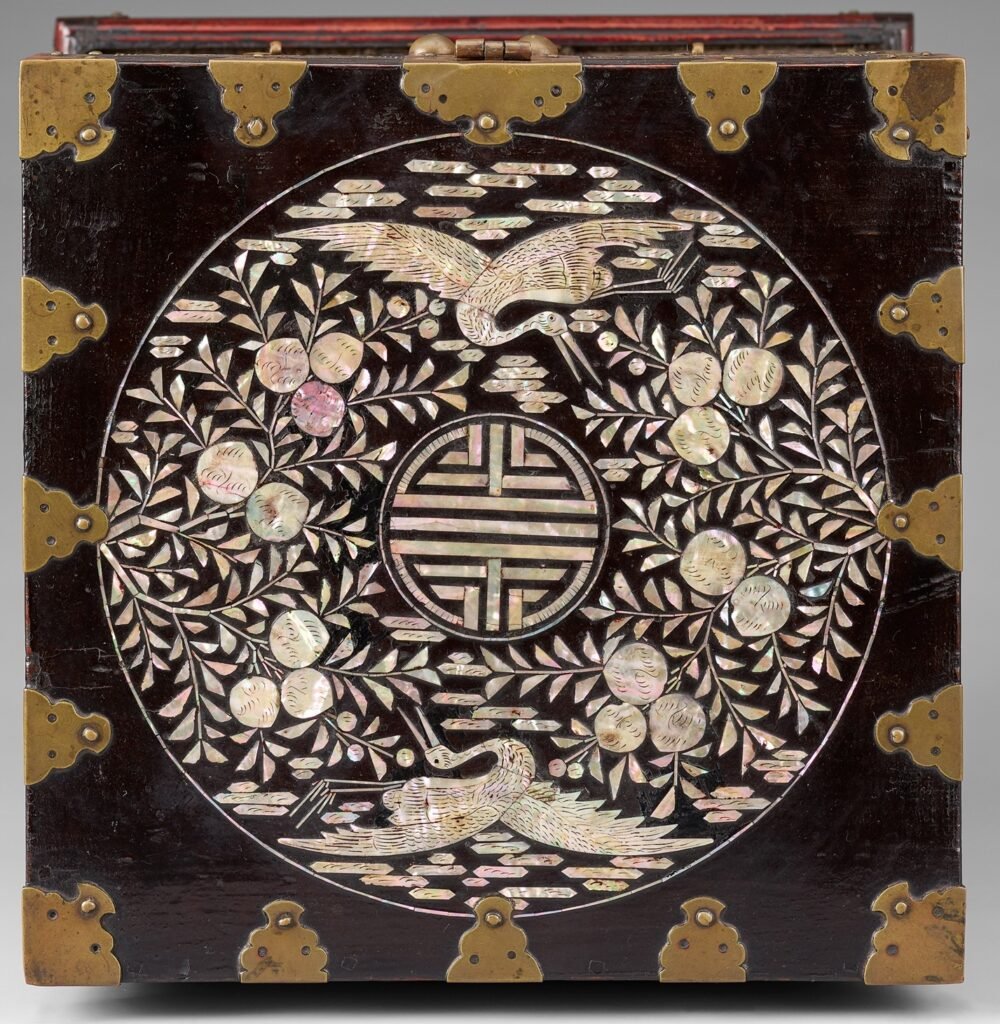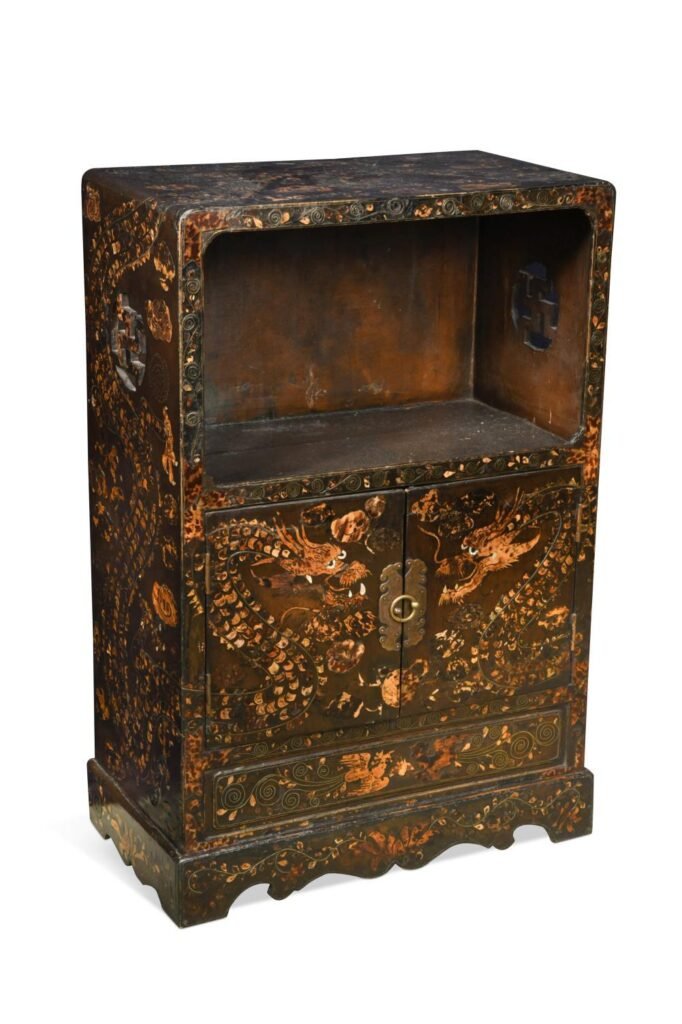PATTERNS SYMBOLISM IN KOREAN ART.
In a previous publication METALWORK PATTERNS ON KOREAN FURNITURE, we listed the various decorative motifs on the hinges of Korean furniture. Below, we examine their meanings.
Korean furniture, such as bandaji (storage chests), jang (wardrobes), mungap (stationery chests), and ham (boxes or cases), is often decorated with symbolic patterns that reflect people’s wishes and aspirations. These patterns are typically engraved on metal ornaments like hinges, handles, knobs, clamps, and locks. They can be categorized into animals, plants, objects, letters, geometric figures, and natural forms.
Animal patterns often feature bats, butterflies, swallows, or fish, while plant patterns commonly include flowers like chrysanthemums, peonies, and pomegranates. Objects such as gourd bottles and yeoui (Buddhist ceremonial tools) are also used. Chinese characters, such as 卍, 壽福康寧, 多男, 壽福, 富貴, and 囍, are frequently incorporated to convey blessings like longevity, happiness, and prosperity.
Natural patterns might take the form of clouds or a crescent moon, while geometric designs include the Taegeuk symbol, Palgwae (The Eight Trigrams), and 卍. Furniture is often adorned with a mix of patterns, each carrying symbolic meaning and expressing the hopes of its owners.
This paper focuses on the symbolic meanings of patterns found in Korean furniture.
Decorative patterns play a significant role in Korean traditional art for several reasons:
Cultural Symbolism: Many decorative patterns in Korean art are deeply rooted in cultural symbolism, representing concepts such as longevity, prosperity, fertility, and protection from evil spirits. These patterns often draw inspiration from nature, mythology, and religious beliefs, reflecting the values and aspirations of Korean society.
Aesthetic Beauty: Korean decorative patterns are renowned for their intricate and harmonious designs. These patterns are often created using meticulous craftsmanship, demonstrating the skill and creativity of Korean artisans.
Cultural Identity: Decorative patterns are an important aspect of Korean cultural identity, serving as a visual expression of Korea’s artistic heritage. These patterns are passed down through generations, contributing to the preservation and promotion of Korean cultural traditions.
Spiritual Significance: Some decorative patterns in Korean art hold spiritual significance, with origins in shamanistic and Buddhist traditions. These patterns are believed to possess protective and auspicious qualities, serving as a connection to the divine realm and promoting spiritual well-being.
Overall, decorative patterns in Korean traditional art serve multiple purposes, ranging from cultural symbolism and aesthetic beauty to functional design and spiritual significance. They are integral to the rich tapestry of Korean artistic expression and continue to inspire admiration and fascination both within Korea and beyond.
LINK: Traditional patterns of Korea.
FIVE CARDINAL COLORS, DIRECTIONS, AND ELEMENTS

- Blue, Green: East – Wood
- White: West – Metal
- Red: South – Fire
- Black: North – Water
- Yellow, Brown: Center – Earth
P L A N T S.
Flowers are frequently used as themes in plant patterns. In one sense, flowers represent beauty, peace, because the Chinese characters (花 – a flower) and (和 – peace) are homophonous.
They are pronounced as “hwa” in Korean. In particular, the Four Gracious Plants (the plum, the orchid, the chrysanthemum and the bamboo shoot) are the most popular for furniture.

Pomegranates: Since ancient times, images of ripe pomegranates bursting open have been valued in Korea, Japan, and other cultures influenced by China as symbols of fertility and abundance.
“Flowers and Birds.” Late Joseon Dynasty. Ink and color on paper. 69.1 × 41.2 cm. Sun Moon University Museum.

Peonies: Peonies, a symbol of wealth and honor, are a favorite motif in Korean art. Happiness, fertility, marital bliss, spring.

Peaches: In Korean folk art, peaches were drawn as a symbol of longevity. Abundance, prosperity, fertility, spring.
Table with phoenix, crane, and peach motif, 1800-1900. Korea, Joseon dynasty (1392-1910). Lacquered wood with inlaid mother-of-pearl. Asian Art Museum, USA.

Pine: To Koreans, the pines are more than just trees. To the living they’re mystical entities that bridged the earth and the skies, and to the dead they’re guardians that protect the tombs. Pine trees have played an important role in Koreans’ lives, from birth to death. So Korean’s favorite tree is the pine. Integrity, longevity.

Bamboo: Bamboo is the symbol of righteous living in a disorderly world and it is the last of the four gracious plants or Sagunja. The green bamboo is usually admired during the thick of winter snow. This is why bamboo represents the winter of the four plants. Integrity, consistency (evergreen).

Grapes: Fertility, many children. Grapes are placed in a woman’s living space to encourage fertility.

Orchids: Orchids are a symbol of virtue and, together with plum blossoms, bamboo, and chrysanthemums, are part of a quartet known as the Four Gentlemen (sagunja) favored by literati painters. This motif is a symbol of loyalty and integrity.

Plum: Indomitable spirit (blooms in late winter in the snow).
Lacquer box with plum tree, bird, bamboo, chrysanthemum and arabesque design.

Chrysanthemums: Constancy (blooms in late autumn, despite frost).
Detail of a lacquered box with inlaid mother-of-pearl chrysanthemum and scroll design.

Creeping vines stand for longevity. It symbolized endurance and continuity as endures the severe cold of winter.
The Four Noble Plants in Korean Art. Also called (Sagunja 사군자) the four gentlemen.
“The plum blossom, orchid, chrysanthemum, and bamboo. The four noble plants represent the cycle of the four seasons (the plum blossom for winter, the orchid for spring, the bamboo for summer, and the chrysanthemum for autumn) and symbolize Confucian traits such as purity, humility, and perseverance.
The four noble plants originated in Chinese art during the Song dynasty (960-1279). In the 15th century, the four noble plants expanded into Korean painting. While drawing and painting the four noble plants, scholars and nobility focused on the plants’ characteristics, reflecting on their lives, bodies, and minds.
The plum blossom (매화) blooms between late winter and early spring. After surviving the harsh winter, its beautiful appearance in snowy weather epitomizes perseverance and hope. A fragrant and elegant plant, the orchid (난초) is often characterized as a feminine beauty and is associated with integrity. The chrysanthemum (국화) blossoms in late autumn, persisting through the first frost. Compared to a noble scholar, the chrysanthemum appears on many ceramics such as Goryeo porcelain. Finally, bamboo (대나무) is an evergreen plant that continues to grow straight and tall throughout the year. Because of these traits, bamboo is described as the spirit of an unyielding and firm governor.” Written By Madeline Chun (전 나영)
A N I M A L S
The main animal patterns on furniture include bats, butterflies, swallows, fish, and other animals considered auspicious, such as the bonghwang (Chinese phoenix), crane, dragon, turtle, and deer.

Tiger: Courage, protection, chases away malevolent spirits.

Magpie: Repels bad luck, attracts good luck (often paired with tiger).

Butterfly: Happiness, free love.
Bat: Homophone for happiness, blessings “bok“

Fish: Diligence, vigilance, academic success, many children.

Mandarin duck: Fidelity

Bats:
Five bats “obok“: Five fortunes: longevity, wealth, health, virtue, natural death.

Crane: Nobility, spirituality, long life.

Wild goose & duck: Happiness, fertility loyalty.
Shortly before a traditional Korean wedding, the future groom presented a pair of carved wood ducks or geese to the parents of the future bride. The wood ducks replaced an earlier tradition in which the groom brought live birds.

Monkey: Monkeys were believed to ward off evil spirits. Their red faces symbolize Yang energy which protects from evil spirits.
White porcelain jar with grapevine and monkey pattern. Joseon dynasty. Collection: National Museum of Korea.

Cat: Protection from evil spirits. The cat has been widely featured in paintings, but less frequently on furniture.

Deer: Friendship, long life, spiritual authority.
In ancient tribal times, deer were believed to be a connection between the heavenly deities and their earthly representatives.

Pheasant: The pheasant symbolized love and a long life together in marriage, Nobility.
Ceremonial pheasant robe of the consort of imperial prince Yeong, Early 20th century (1922). Collection: National Palace Museum, Seoul.
A jeogui (翟衣) is an elegant ceremonial robe with a pheasant pattern, which was worn by Joseon queens on the most formal occasions.
MYTHICAL ANIMALS

Phoenix: Elegance, virtue, morality, prosperous future, the queen.

Dragon: Heavenly power, good luck, repels evil, the king, rain.
Symbols of the cardinal points:
- Blue dragon of the east
- White tiger of the west
- Red phoenix of the south
- Black tortoise-snake of the north.
RELIGIOUS SYMBOLS.
Most of the religious motifs were engraved on wooden furniture intended for religious celebrations or reserved for scholarly use. They include Buddhist and Taoist motifs.

Yeouido, clouds, lotus, ansangs patterns.

Yeouido pattern: (motif on the top side of the table in picture).
Yeoui [如意]’, means “everything goes according to prayers”, is also conventionally denoted by a symbol in the form of a bent tool derived from Buddhist rituals. Originally, the yeoui was held by monks and used for pushing and pulling, but it is now represented as a crook in furniture patterns.

Taegeuk pattern: The taegeuk 태극 is the circular symbol that looks like interlocking commas. Ultimate equality and balance, cycle of life (Chinese: yin yang).
In the ancient kingdom of Joseon, the design was used to express the hope for harmony of yin and yang. It is likely due to the earliest spread of ancient Chinese culture at the beginning of the Joseon dynasty.

Manja pattern: Manja (만자) literally means “letter Man” is also called Srivatsalksana in Sanskrit. For those of us in the West this is often confused with the German Nazi swastika symbol but in fact it’s been around for about three thousand years. The swastika is an equilateral cross with arms bent at right angles and all in the same direction, usually to the right, or clockwise. It’s a symbol of prosperity and good fortune and it originally represented the revolving sun, fire, or life.

Palgwae pattern: The Eight Trigrams for Divination is a set of symbols from China intended to illustrate the nature of reality as being composed of mutually opposing forces reinforcing one another. Bagua is a group of trigrams—composed of three lines, each either “broken” or “unbroken”, which represent yin and yang, respectively.


Clouds pattern: Good harvest, absolute power of heaven, enlightenment. Cloud is the most common nature pattern. In the past, people believed if they pursued virtue while they lived, they could rise to the sky riding a cloud or attain Buddha-hood. Cloud patterns are also used to represent the dragon’s divine spirit.

Lotus pattern: Purity, creation, birth, enlightenment
Ansang pattern:
Ansangmun (眼象紋) is a pattern whose name derives from its resemblance to an elephant’s eye, often used in conjunction with Yeouidomun (如意頭紋). It’s frequently carved on furniture that embodies frugality. The ‘eyesang (眼象)’ pattern commonly appears in various forms of Buddhist art, including Buddha statue pedestals, stone lanterns, stone pagodas, and wooden architecture, making it one of the most prevalent patterns alongside the lotus motif. Despite its significant symbolism, a clear and detailed explanation of its meaning and implications is still lacking.
However, the Chinese character for Ansang (眼象) uses the character for elephant (象), and the elephant is a symbol of nobility and authority, but more emphasis seems to be placed on the story that it symbolizes a blooming lotus flower.






Three carved Ansang patterns on the drawer. Collection: Yeoju Museum

Collection: ASAHI GROUP OYAMAZAKI VILLA MUSEUM OF ART, Kyoto prefecture, Japan.


Ansang pattern on the bottom of a wonban (photo left)
Collection: National Folk Museum of Korea.
C H I N E S E C H A R A C T E R S.



“Shou or Su 壽” is the Chinese word/character for “longevity”. This character is usually found on textiles, furniture, ceramics and jewelry. The ideograph may appear alone or be surrounded by flowers, bats, or other good luck symbols, but will always hold a central position.

Good fortune 복,福 (Chinese: Fu)

“Double happiness – shuang hsi 雙喜” is a Chinese traditional ornament design, commonly used as a decoration symbol of marriage.
T H E T E N L O N G E V I T I E S

- Sun
- Mountains
- Water
- Clouds
- Crane
- Deer
- Tortoise
- Pine tree
- Peaches
- Herbs of eternal youth or fungus of immortality
The Sun, the Eternal Light and Life
The sun is a symbol of longevity and immortality because it never fails to rise every day and give light and life to all living things. It also nourishes the plants and animals. The sun has renewable energy that can be harnessed for solar power or thermal energy. The sun is a constant and dependable presence that does not change.
Mountains, the Unchanging and Immovable
Mountains are a symbol of endurance and immortality because they are unchanging and immovable. They can withstand the passage of time and the elements. Mountains are also linked to Daoist immortals, who are said to dwell in the mountains or seek the herb of eternal youth there.
Water, the Life-Giving and Powerful
Water is a symbol of life and longevity because it is essential for all living things. It can also symbolize harmony or power depending on how it flows. Water can be calm and peaceful like a lake or a river, or it can be fierce and unstoppable like a waterfall or a flood. Water is also versatile and adaptable as it can take different shapes or states in different environments.
Clouds, the Harmony of Yin and Yang
Clouds are a symbol of harmony and balance because they represent the combination of the dual principle of Yin and Yang. Yin and Yang are the opposite forces that make up everything in the universe. They complement each other and create harmony when they are in balance. Clouds also resemble the shape of the herb of eternal youth, which is another symbol of longevity.
Crane, the Faithful and Heavenly
Cranes are a symbol of eternal youth and fidelity because they have a long lifespan and choose a mate for life. They also have white feathers that signify purity and grace. Cranes can fly high in the sky, which makes them closer to heaven. Cranes are often depicted with peaches or the herb of eternal youth in their beaks.
Deer, the Peaceful and Youthful
Deer are a symbol of harmony and happiness because they live peacefully in the forest with other animals. They also have a long lifespan and can find the herb of eternal youth with their keen sense of smell. Deer are graceful and gentle creatures that symbolize beauty and elegance.
Turtles or Tortoises, the Wise and World-Carrying
Turtles are a symbol of longevity and wisdom because they have a long lifespan and a slow but steady pace. They also have a curvy shell that resembles the shape of heaven, while their flat body resembles the shape of earth. In Taoist philosophy, turtles are supposed to carry the world on their back. In Buddhism, turtles are also an important symbol as they were used for divination in ancient times.
Pine Trees, the Evergreen and Resistant
Pine trees are a symbol of immortality and resilience because they are evergreen, meaning they stay green throughout the seasons. They can also live up to 1,000 years, which is very long for a tree. Pine trees are resistant as they can bend under pressure rather than break. Pine trees are considered to be the national tree of Korea and are mentioned in their national anthem.
Peaches,
The Herb of Eternal Youth, the Legendary Mushroom
The herb of eternal youth is a legendary mushroom that grants immortality to those who eat it. It is also known as Yeongji in Korean. It is said to grow only in remote mountains or islands where only deer or cranes can find it.
Symbolic Meaning of Patterns on Furniture – Jung Yonhak (Curator, The National folk Musem of Korea)
Korean furniture, such as bandaji, jang and nong (wardrobes), mungapjang (stationery chests), and ham (boxes), are typically decorated with symbolic patterns implying wishes and expectations of people).
These patterns are engraved on metal ornaments such as lock plates and hinges, handles, knobs, clamps, locks, and they can be classified into animals, plants, physical objects or letters, geometrical figures….
Animal patterns usually take the forms of bats, butterflies, swallows, or fish. Used in plant patterns are mainly flowers such as chrysanthemum, “maehwa“, peony, pomegranate, and “mokdan“.
The main physical objects include gourd bottles and “yeoui” (ceremonial tools in Buddhism).
Pieces of furniture and their ornaments are also decorated with Chinese characters such as 卍, 壽福康寧, 多男, 壽福, 富貴, and 囍. Some of patterns can take natural forms like the clouds or a halfmoon. In addition, other patterns found include geometrical figures such as “Taegeuk” design, “Palgwae” (The Eight Trigrams for Divination) and 卍. In general, a piece of furniture is decorated with various forms of pattern, each of which has a symbolic meaning and implies wishes of people.
PATTERNS ON FURNITURE.
There is no systematic classification of patterns on furniture. The classification in this study includes categories such as animals, plants, physical materials, letters, natural objects, and geometrical figures.
The main animal patterns on furniture are figures of bat, butterfly, swallow, fish.

Since a bat is spelled “pyeon-bok” in Chinese and the character has the same pronunciation as [福] meaning “good fortune” – in other words, since the Chinese characters and [福] are homophonous – the bat design is regarded as symbolizing “good fortune” or “good luck.”
The design of twin bats means a double fortune. And as shown in the Chinese classics “Sangseo-Hongbeom (尙書-洪范),” the design of five bats represents the Five Blessings called Obok: longevity (壽), wealth (富), health (康寧), love of virtue (德), and natural death (考終命).
Today, the Five Blessings is also interpreted as “luckiness (福), happiness (祿), longevity (壽), a matter for congratulation (禧), and property (財)” or “longevity (壽), wealth (富), nobility (貴), comfort (安樂), prosperity (子孫萬代).” A red bat implies “great luck,” because the Chinese characters [紅 (red)] and [弘 (wide)] are homophonous. And the design of a bat with a coin in the mouth means the “luck of fortune.” In addition, there are various designs expressing “good fortune” like the combination of a bat and a child, a bat and a peach, or a bat, a peach, and two coins. If a bat is depicted upside down, it is to express a symbolic meaning that good fortune is pouring out.

The butterfly is considered as symbolizing the male gender, because it looks about for flowers. Due to its showy pattern and gorgeous wings, the butterfly design is especially favored by women. The movement of butterflies’ wings suggests pleasure, while the use of the butterfly pattern in amulets consecrating romantic love mean lends a double implication of (usually marital) faithfulness. It was believed that if the members of a couple kept safe the butterfly amulet, their relationship would improve: the husband would not be dissolute, and the couple would leave their offspring well-off. There is thus another symbolic sense in the use of the butterfly pattern to mean the flourishing of many thousands of generations of offspring. In addition, since the Chinese character (蝶) means a butterfly and is pronounced “jeop” meaning an advanced age, the butterfly design is also applied to express longevity.

Swallowtails, a bird, called “제비꼬리” in Korean, derive their name from their shape. According to “Heungbu-jeon“, one of the classical Korean operas, a swallow is one kind of beast, or Heungbu, that brings good luck to his family. Swallows are messengers of arrival especially in so far as they portend the spring and the return of all things to life. This role is commemorated in popular sayings, such as “it is bad luck unless a swallow comes” and “the swallows” early return and breeding predict fruitful years”.
Swallowtail patterns on these fittings holding the doors of a clothing chest.

Fish are accounted protective symbols of household wealth on account of their keeping their eyes open during sleep.
Locks on safes or furniture containing money, secret documents or other valuables are often thus figured as or decorated with fish.
Fish not only denote guardianship but wealth and abundance.
Other animals that have been considered auspicious : Chinese phoenix, crane, dragon, turtle, and deer.





On furniture, you can also see the grass design such as dangcho-mun or indong-mun or their combination, which is called the indong-dangcho-mun. Both the two plants “dangcho and indong (woodbine)” belong to the vine, dangcho is known to have broader vines compared with indong (woodbine). The dangcho-mun is one of the most widely used grass designs in the Tang dynasty of china. Indong (忍冬) is a vine plant that is found in Korea and China’s mountainous areas, and the name implies the meaning of a patient grass that stands the cold of winter. The design of vines on furniture also reflects the wish for the prosperity of descendants.
COMBINATIONS OF PATTERNS AND THEIR SYMBOLIC SIGNIFICANCE.
In Korean folk paintings, flowers with birds, grass with insects, flowers with butterflies, and bats often appear, each carrying symbolic significance. For example, a painting of flowers with birds signifies that a married couple will live in conjugal harmony, a theme often depicted on folding screens. Every decoration on furniture has symbolic importance, and the combinations of various designs express specific wishes, as shown below:
卍 + bat : Great fortune
卍 + vines : Having many kids
Two bats : Twin fortunes
Five bats : Five blessings
Vines + 卍 + bat : Descendants’ continuous prosperity
Vines + 壽 + 囍 + bat : Longevity, fortune, happiness, and having many kids
卍 + cintamani : Everything will turn out as one wishes
Korean brass coin + bat : Blessing of wealth
Cintamani + bat : Everything will go well.
Taeguk + butterfly : Eternal pleasure
Butterfly + vine : Descendants’ prosperity and longevity
Butterfly + flower : Pleasure
Flower + bottle : Harmony and peace
SAMPLES OF DECORATIVE MOTIFS ON KOREAN FURNITURE.
It is not an exaggeration to say that furniture like soban and bandaji accompanies people throughout their entire lives. These pieces play crucial roles in daily life, such as carrying food and safeguarding important items, thereby contributing to the health and well-being of the home. During the making of soban, designs symbolizing the repulsion of evil spirits and the wish for good fortune were often engraved. Additionally, the character wang [王], meaning king, was sometimes engraved upside down on the back, using the power of a tiger to ward off evil spirits. The reason why soban with tiger-shaped legs are called hojokban is that the tiger, considered the king of the mountains, is believed to protect the food on the table. Moreover, this design symbolizes a wish for the soban to be as strong as a tiger’s foot.
The designs on furniture vary by the space they occupy. For instance, the closets and cabinets in the main room, intended for the hostess of the household, feature more elaborate decorations than those in the detached living room, which are meant for the host. Furthermore, furniture for ladies often showcases delicate and ornate designs of feldspars, including motifs like yin-yang, flowers, and butterflies. In contrast, furniture for men typically features simpler and more natural designs of feldspars, such as the Four Gracious Plants (plum, orchid, chrysanthemum, and bamboo), characters like gilsang (吉相) meaning lucky omen, 卍, and 亞 meaning suppression, or poetry that reflects a scholar’s personality.














Collection: The Met Museum, New York. USA

Collection: LACMA Los Angeles County Museum of Art, USA.

Collection: Sookmyung Women’s University, Seoul.





Peach & pair of birds on the top, Turtle pattern & plum blossom on the front. Pine tree, crane and deer with mountain in the background on the right side. Bamboo on the left side.
Collection: National Museum of Korea.
THE TORTOISE SHELL PATTERN.

Collection: Ewha Womans University Museum, Seoul.






